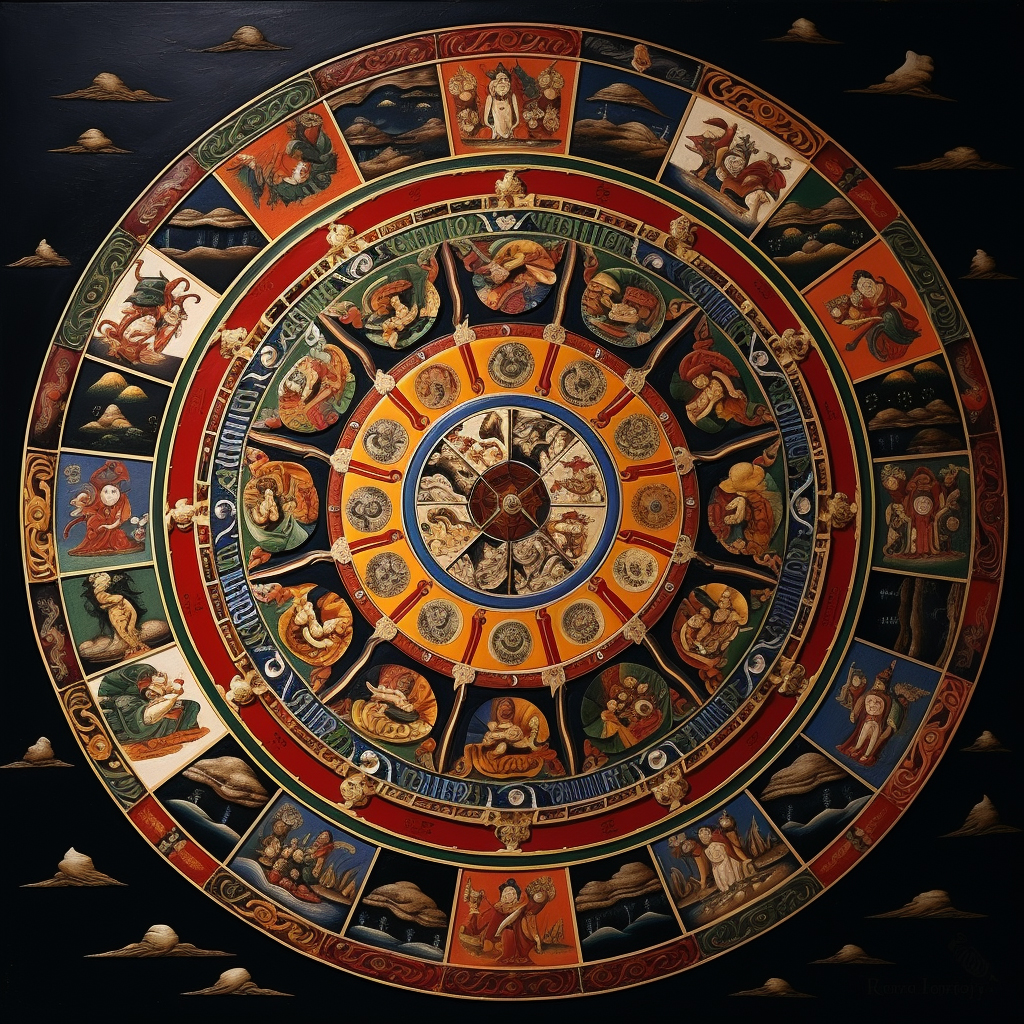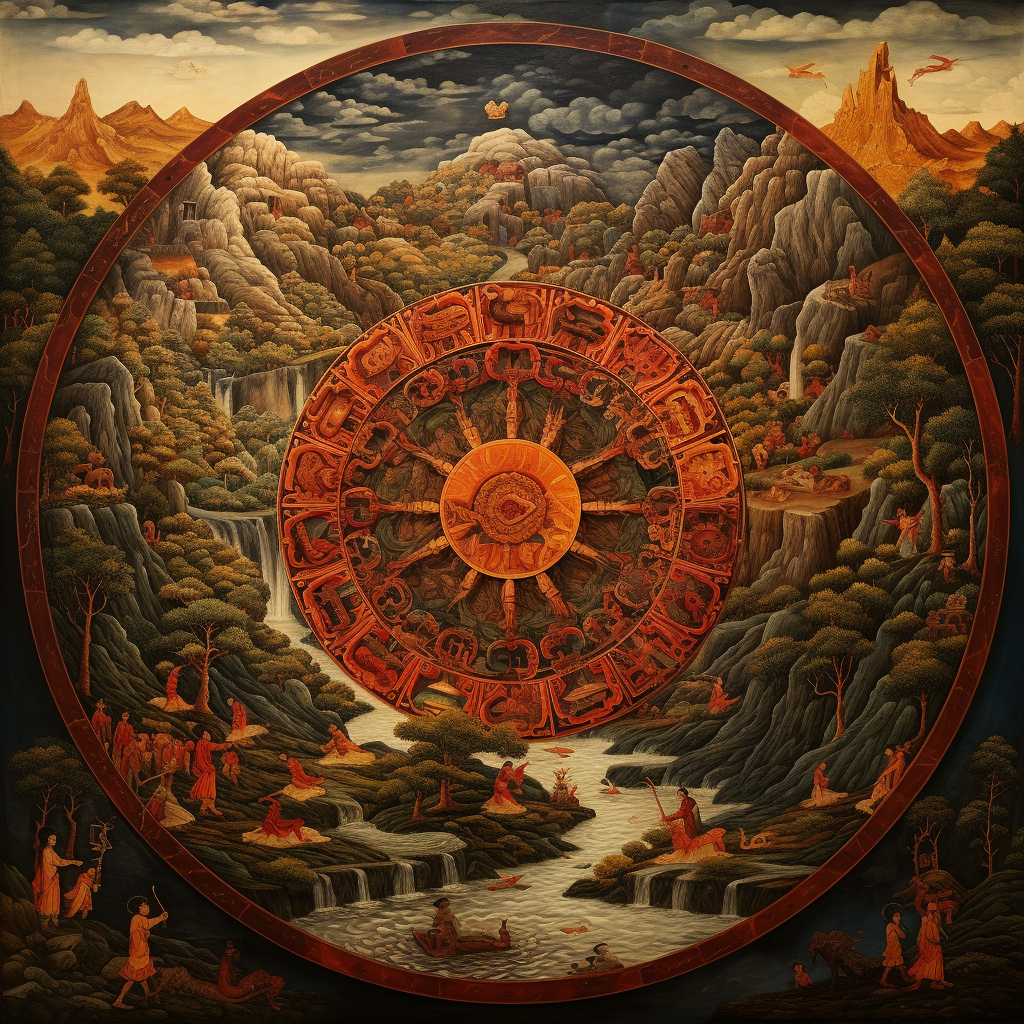A comprehensive overview of the practices associated with the intermediate scope in the Lamrim teachings.

The Tibetan Buddhist Lamrim teachings on the intermediate scope focus on progressing beyond the initial stages of spiritual practice and aspiring for liberation from the cycle of birth and rebirth (samsara).
Lamrim teachings emphasize a deeper understanding of the suffering inherent in samsara, including the suffering of change, the suffering of pain, and the pervasive suffering of conditioned existence. This understanding serves as a motivating factor for spiritual practice.
Renunciation of Samsara
The intermediate scope begins with the recognition that samsara, the cycle of birth and rebirth, is marked by suffering, impermanence, and unsatisfactoriness. Practitioners develop a strong sense of renunciation, seeking liberation from this cycle.
Tibetan Buddhist Lamrim: Developing Renunciation for Samsara
Developing renunciation for samsara is a fundamental aspect of Tibetan Buddhist Lamrim teachings. Renunciation in this context refers to a sincere and strong desire to be free from the cycle of birth and rebirth (samsara) due to its inherent suffering and unsatisfactoriness.
To sincerely enter the Buddhist path is to renounce this life and begin working on improving future lives. Of course, in the process, this life improves dramatically, and that motivation sneaks into every practitioner’s psyche. But in order to achieve peace of mind in this life, the motivation must be to improve future lives—one of life’s enigmas.
Developing renunciation goes together with aspiring for a meaningful and spiritually oriented life. Practitioners seek a higher purpose and aim for lasting happiness through the pursuit of liberation.
The Four Noble Truths
The Four Noble Truths are foundational teachings in Buddhism, expounded by Siddhartha Gautama, known as the Buddha. They form the core of Buddhist philosophy and provide a framework for understanding the nature of suffering and the path to liberation.
Suffering and Salvation: Understanding the Four Noble Truths of Buddhism
1. The Truth of Suffering
The First Noble Truth encourages us to acknowledge and embrace the reality of suffering as an essential first step towards comprehending and addressing its causes, as further explained in the subsequent Noble Truths. It’s crucial to understand that “suffering” encompasses a wide spectrum of human experiences and states, not just physical pain or unhappiness.
The Buddha’s focus was not on philosophical debates or speculations about the existence of deities. Instead, Buddhism emphasizes trust in the process leading to liberation from suffering rather than belief in hypothetical entities, or metaphysical systems.

Many contend that his teachings don’t constitute a religion because the Dharma primarily aims to alleviate the suffering. All of Buddha’s teachings are directed towards this purpose.
Fundamentally, the First Noble Truth asserts that suffering is an inherent part of human life, forming the cornerstone of the Buddhist journey toward freedom and enlightenment.
Human Suffering: Understanding Dukkha in the First Noble Truth
2. The Truth of the Cause of Suffering
The Second Noble Truth, as taught by the Buddha, instructs us to “abandon origins” and is also known as “The Truth of the Cause of Suffering” or “Samudaya.” Here, the Buddha explains that the mind is the primary cause of suffering.
This truth pinpoints “tanha,” or craving, attachment, and desire, as the root cause of suffering. It suggests that the primary reason for human suffering is the unrelenting and clinging desires for things, people, and even our own “self.”

The Buddha further points out that this harmful pattern of the mind is due to a lack of understanding of the true nature of reality.
We mistakenly assign qualities to objects and people and then form attachments to objects, believing that they will bring us satisfaction and happiness.
We hold the belief that these qualities are inherent in the objects or people themselves, as if these positive attributes exist independently of our minds and perceptions, and are part of the object or person.
However, this is a misinterpretation of reality. This “ignorance” to the truth of reality is the source of all our problems.
Transforming Desire into Liberation: Practical Wisdom from the Second Noble Truth
3. The Truth of the Cessation of Suffering
The traditional story of the Buddha placed Siddhārtha Gautama in meditation under the bodhi tree. He came to understand a way to end suffering. In that instant, he attained enlightenment and became the Buddha, the awakened one.
Nirvana is a deep state of inner peace, satisfaction, and freedom from the ongoing cycle of suffering and rebirth (samsara). It’s often described in negative terms, like the absence of suffering, rather than positive terms, because it surpasses regular language and thought.
Nirvana signifies a move away from a self-focused, ego-driven view to a state of no ego and a connectedness with all life and events. It’s intimately linked with being completely in the moment, unburdened by past regrets and future worries. It means perceiving reality as it truly is, unskewed by the ego.

To end suffering, one must tackle its root causes: craving, attachment, and desire (as outlined in the Second Noble Truth). By eradicating these mental tendencies, suffering can cease.
The Third Noble Truth gives hope and encouragement to Buddhist followers, highlighting that suffering is not a permanent, unavoidable aspect of life. It encourages a journey of inner change and freedom.
True Cessations: The Transformative Journey of the Third Noble Truth
4. The Truth of the Path to Cessation
A genuine spiritual journey is one that guides towards an authentic end of suffering. Just as physical paths take us from one place to another, inner paths consist of thoughtful reflections and insights that transition from a state of suffering to a tranquil state of freedom.
To achieve a real cessation, a practitioner needs to identify and follow a true path. There are various forms of true cessations, and equally, numerous authentic spiritual routes exist.

The Fourth Noble Truth also presents the Eightfold Path, which is a set of ethical and mental guidelines for living a life that leads to the cessation of suffering.
- Right Understanding
- Right Intention
- Right Speech
- Right Action
- Right Livelihood
- Right Effort
- Right Mindfulness
- Right Concentration
Right Living, Right Mindfulness: Navigating the Fourth Noble Truth
Training in Ethical Conduct
Maintaining ethical behavior is crucial at the intermediate stage of spiritual growth, as it lays the groundwork for further advancement. Practitioners avoid harmful actions and pursue positive ones.
When someone truly understands that their actions will always have consequences that they cannot escape, they are motivated to think carefully about the outcomes of their actions.
This deep understanding discourages them from acting on selfish desires at the expense of others, as they realize they cannot act without facing consequences.
The strength of Karma is in its ability to deter people from harming others, reinforcing their dedication to moral conduct.
Tibetan Buddhist Lamrin: Actions and Their Effects
Deeper Meditation Practices
As individuals progress through the intermediate scope, they engage in more advanced meditation practices, including mindfulness, concentration, and insight meditation. These practices help develop wisdom and insight into the nature of reality.
Mindfulness meditation is mental training. Practitioners develop the ability to observe the mind, control its focus, and sustain concentration. It serves to overcome the problems of uncontrolled behaviors due to an unruly mind.
Mindfulness Meditation Mastery: A Journey to Observing, Directing, and Sustaining Mental Focus
Seeking Liberation
The ultimate goal of the intermediate scope is to attain liberation (nirvana) from the cycle of samsara. Practitioners aim to break free from the cycle of birth and rebirth and achieve a state of lasting peace and happiness.
Objects have no intrinsic properties independent of the mind that perceives them. The self also does not exist intrinsically, as a substantial and independent entity, independent of the mind and body that generates it.
Every belief in your head begins when sense information from the outside world enters your awareness as data.
From there, your mind processes the raw data and adds meaning and interpretation. You have complete control to interpret the meaning of any sensory data.
There is no intrinsic meaning—no one correct interpretation that you must accept.
This is what Buddhists refer to as Emptiness of Meaning, also part of Anattā or Śūnyatā. Enlightened masters realize the empty nature of both the self and all phenomena.
Emptiness of Self: The Key to Buddhist Enlightenment
The Tibetan Buddhist Lamrim teachings on the intermediate scope guide practitioners to deepen their understanding of suffering, cultivate compassion and bodhicitta, and engage in advanced practices aimed at attaining liberation from samsara. This stage represents a significant progression on the path to spiritual awakening and, ultimately, full enlightenment and Buddhahood.

